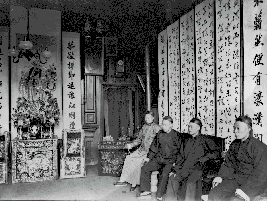SOCIAL AND SPIRITUAL LIFE IN EARLY CHINATOWN

Interior
of Chinese Joss House
Courtesy B.C. Archives: D-05668
Joss Houses
The nature of joss
houses can be a mystery to those of us steeped in
western philosophical and religious influences. While
the citizens of the day appear quick to dismiss this aspect of Chinese
life as idol worship, the joss houses seem to have served a social as
well as spiritual function. They were a way
for the Chinese to remain in touch with their culture and roots. Many of the “joss houses” in Victoria were more like shrines for ancestors or
patron saints for the various tongs in the city.
Joss houses or
Chinese temples did not appear to attract much discussion or observation
amongst early Victoria’s white population, except perhaps to
serve as another excuse to label the Chinese as
“heathen.” Several of these structures can
be found on the 1885 Victoria fire insurance map, but coverage of them
in the newspapers of the day is scant.
These joss houses
were shrines for usually one god or saint-like individual, for whom
there would be a statue on display. I
hesitate to use the term “worship” as the act of observing these
individuals, as the Chinese religion is a complex hybrid of influences
from Taoism to legend and reverence for ones ancestry. However,
at the very least, the term “commemoration” seems appropriate.
The Colonist has a story
of how a “joss” statue was found in a Chinatown shop. The
observer, finding something familiar about the appearance of the statue,
queries the shopkeeper, and discovers that the statue is a
representation of Robert Beaven, Public
Works Commissoner at the time and who was briefly Premier of British
Columbia in the early 1880s.
While it is very
unlikely that a statue of “Joss Beaven” would end
up in a joss house, it does suggest that the concept of “worship” for
the Chinese was somewhat different than that of Western religions. The statue could have been intended as what
westerners would view as a glorified “thank you note” to Beaven for
permitting Chinese to gain employment through public works contracts.
Sources:
Daily British Colonist, 21 March 1878.
Lai, Cheun-Yan David, Chinatown
the Forbidden City, Orca, Victoria, 1991.
 
|